-
-
-
|
-
- Samoa Map
Map of Savaii
-
|
-
-
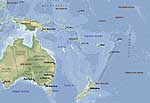
-
-
-
Map of
-
the Pacific
-
|
-
-
-
-
-
|
- latest picture: June 12, 2009
- click a picture to see details
|
-
-

|
-
-
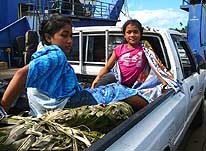
|
-
-
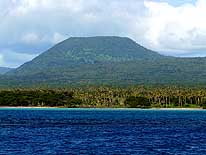
|
- 148
On June 9th, 2009, Emil is driving
- our LandCruiser onto the ferry „Fotu-o-
- Samoa II“ that will sail in 1½ hours to
- the Samoan sister island of Savaii
|
- 149
The two girls make themselves
- comfortable on the bridge of their
- pick-up for the choppy sea journey
|
- 150
Upolu – the main island –
- is bidding farewell
|
-
- Exactly one week later, at 2pm, we are boarding the ferry to the island of Savaii. With
the ‘Giant African Snail’ spread on the island of Upolu but not yet on Savaii, our LandCruiser is sprayed by the
quarantine before embarking. The crossing is short and bumpy: After 1½ hours, we already
approach the port of Salelolaga in the Southeast of the island.
|
-
-
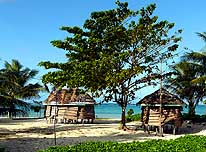
|
-
-

|
-
-

|
- 151
Two of the traditional, mostly very
- simple “Beach Fale“ that can be rented all
- around the island for approximately 60 Tala
- per person (= US$ 23), including breakfast
- and dinner. Here on the East coast in Lano
|
- 152
Peaceful tropical scenery
- along the East coast near Lano
|
- 153
“Beach Fales“ – here near
- Faga on the East coast –
- guarantee an authentic Samoan
- accommodation experience
|
-
- It is mid afternoon, when we slowly drive along the palm fringed East coast to the
North. It looks more rural than in Upolu,
less populated and wilder. Now and then, a small community pops up with an impressive
church – like everywhere – towering at its center and some breezy beach fales
lining the shore. Arriving at the Northern tip, we drive past a vast field of old lava
flow, reminder of the eruptions of Mt. Matavanu between 1905 and 1911, where fresh green
plants started to grow again.
|
-
-

|
-
-

|
-
-

|
- 154
Coconut palm trees fringe a
- stretch of the East coast near Faga
|
- 155
The shrine in Puapua at the
- East coast with Maria and child Jesus
- is protected by a “fale”-shaped roof
|
- 156
On the Northeastern corner
- lies a lava field between Mauga and
- Saleaula, scattered with green plants.
- It is witness of the Mt. Matavanu
- eruptions between 1905 and 1911
|
-
- We check in at the Boutique-style Beach Resort “Le Lagoto”, situated at one of
the Northerly sandy beaches, once more at a reduced rate, arranged by the Ministry of
Tourism. Our traditionally built bungalow is spacious, but facing the street, which shows
to be not entirely lifeless during the night. Additionally, each morning at 4am we are
woken up by the honking local bus that lets passengers know that it is arriving.
|
-
-
-
-

|
-
-

|
-
-
-
-

|
- 157
Another of the impressive
- churches is in the village of Salelologa
- on the East coast, where the ferry
- landing is close by. Mostly there
- are several churches in each village
|
- 158
At the evening prayers, the
- empty propane tank has the function
- of a church bell. The tank is hit with
- a stick. At the first strucks of the “bell”,
- all activities cease. At the second ones
- each family gathers for evening prayer
- and at the third time the vesper is over
|
- 159
“Fale”-style villages are the
- most characteristic feature in Samoa
- (North coast near Safai - Fagamalo)
|
-
- At our tropical fruit breakfast at the open air beach restaurant, we meet Andrea and
Frank with their two children Sarah and Roger – Germans, who migrated to New Zealand’s South Island three years ago. We connect
immediately and it feels good to be able to talk animatedly about things of mutual
interest. Emil is absorbed in such an extent in the conversation, that at 9am I have to
remind him that actually we want to surround the only 659 sq.mi. small island today as the
day looks promising with blue skies and sun.
|
-
-

|
-
-

|
-
-

|
- 160
A rainbow appears over the
- restaurant of „Le Lagoto Beach Resort”
- in Fagamalo on the North coast,
- where we spend three nights .....
|
- 161
..... and enjoy every morning
- a tropical breakfast consisting of fruits .....
|
- 162
..... and the sunset in the
- evening at the swimming pool
|
-
- We head west along a lovely coast with beautiful outlooks to the sea. Grazing horses
– still a mean of transport in Savaii – undermine the peaceful rural scene.
Then, we approach Cape Mulinuu, the most westerly point of Savaii. Samoan like to promote
the idea that this is the most westerly location of the globe where today ends –
everything after that being already tomorrow. It’s not exactly like that: The
American Midway Islands as well as also the Howland & Baker Islands lay a bit more to
the West, apart from the most westerly Aleutian Islands in Alaska that are actually
situated already west of the 180° meridian, but have the same time zone as Hawaii –
everything sounds pretty complicated!
|
-
-
-
-

|
-
-
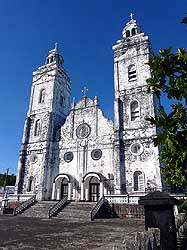
|
-
-
-
-

|
- 163
A grave of a departed is
- lovingly built in the shape of a
- house at the North coast. Graves –
- sometimes monumental structures –
- are often to be found near the homes
|
- 164
The weathered church
- in Safotu at the North coast
- has still an original character
|
- 165
We are driving through a taro
- plantation with huge leaves towards
- Cape Mulinuu, the most westerly
- point of Savaii. Taro is the main
- diet of the Samoan people
|
-
- Emil’s eyes are now fixed more and more to the odometer. Exactly at 655'127.6 km he stops. Why? This
funny number is marking our 400’000th driven mile on our around-the-world-journey
since October 16th, 1984 (1 mile = 1.609344 km minus 11’390km driven before leaving
on October 16th, 1984). Of course, we want to capture this special milestone with a
picture and give it a toast. It is wonderful that it happened coincidentally just at this
beautiful and famous spot.
|
-
-

|
-
-

|
-
-

|
- 166
The North coast direction West
- is lush green and very beautiful
|
- 167
Natural swimming pools along the
- shore are the special feature of Savaii
- – partly fresh water, partly sea water
|
- 168
„Forgotten” palm covered
- islands along the North coast
|
-
- As soon as we head south, the weather changes abruptly and heavy rain starts to fall,
hiding every view for many miles. Why do we not stop for a lunch break? The weather might
approve in the meantime. But only at the ‘Nuu Black Sand Beach’ in the South we
find a place to pull out and eat our picnic: bread, cheese, boiled eggs, ham und fruits,
and – as always – accompanied by a big bottle of the local Samoan Vailima beer.
|
-
-

|
-
-

|
-
-

|
- 169
We reach Cape Mulinuu,
- the most westerly point of Savaii .....
|
- 170
..... where the odometer of our
- LandCruiser reaches 655'127.6 km,
- what means we accomplished exactly
- the 400'000th driven mile of our
- journey around the world since
- Oct. 16, 1984 (1 mile = 1.609344 km
- minus 11'390 km driven before starting)
|
- 171
A nostalgic weather beaten
- church sits on a beautiful spot near
- Falealupo at Cape Mulinuu
|
-
- Our speculation works out even: Soon the skies clear and the sun returns. But time is
too short now to backtrack to Cape Suisui to see the famous Alofaaga blowhole at the
Southwest corner. It is also too short to visit the Afu Aau waterfall in Palauli in front
of us, if we want to be back at our Beach Resort before dusk.
|
-
-

|
-
-
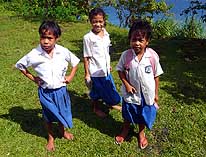
|
-
-

|
- 172
The Southwest coast is rough.
- Huge waves crash against the
- shore at Samata-i-Tai
|
- 173
On their way back home,
- three curious school
- girls stop at our car
|
- 174
A traditional thatched house
- is nestled between black lava and
- tropical green at the Southwest coast
|
-
- However, two days later, we enjoy these two impressive tourist attractions. When we
approach the blowhole, the ocean is raging from a close storm; the waves are crashing
against the black lava shoreline with a ferocious force, showering our LandCruiser
constantly with saltwater. Water fountains skyrocket in the air, falling then like
fireworks in cascades back to the sea.
|
-
-

|
-
-

|
-
-

|
- 175
The Afu Aau Waterfalls at
- Palauli in Southern Savaii are surrounded
- by jungle foliage. The biggest fall plunges
- into a three meter deep refreshing pool .....
|
- 176
..... that is also fed
- by delicate “falls”
|
- 177
Two small cascades of the
- Afu Aau Falls, which tumble
- into the Falealila stream
|
-
- The most exciting performance, however, presents the Alofaaga blowhole itself: With an
incredible power, it tosses a jet of water about 200ft into the blue sky – a
beautiful spectacle! From this incredible force of nature we head to the peaceful Afu Aau
waterfall, nestled in lush tropical foliage.
|
-
-

|
-
-

|
-
-

|
- 178
Some remnants of a distant
- storm are raging at the rough lava
- coast in the South of the island
|
- 179
With an incredible power, the
- Alofaaga blowhole at Cape Asuisui
- near Taga in the South tosses a jet
- of water about 200ft. into the air
|
- 180
The huge waves crashing
- onto the lava coast in the South
- produce beautiful water fountains
|
-
- It is a perfect place to say good bye to laid-back Savaii. Two hours later, we are
already sailing back to Upolu. The sea is
pretty rough; we are sailing also against the waves and are glad when we reach land
safely.
|
-
-

|
-
-

|
-
-
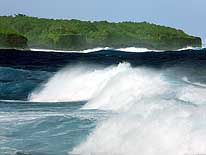
|
- 181
Two girls doing laundry
- where the river drops straight
- into the stormy ocean
|
- 182
Wind and waves have cut
- an arch into the black lava
- rocks on the South coast
|
- 183
Some remnants of a distant
- storm has whipped up the ocean on the
- South coast – where are the surfers?
|
-
- The remaining days until our departure spin away: We are sorting out pictures, updating
our website and dissolve our temporary household. The closer the 1st of July moves, the
sadder we become. Samoa has been three months home away from home. It was a peaceful and
happy time on this very beautiful and relaxed island, where on May 8th, we were also able
to celebrate our 40th wedding anniversary and
on June 7th our 9’000th day on the road
around the world.
|
-
-

|
-
-

|
-
-

|
- 184
A young boy carries his
- heavy coconut load on a
- pole over his shoulder
|
- 185
Children are always ready
- to pose for a picture
|
- 186
There is nothing to hide. The
- whole household is visible for
- everybody at the traditional “Fale”
|
-
- This small dot in the Pacific Ocean with its welcoming people has enriched our lives.
When at midnight “MV Lady Naomi” leaves for Pago Pago in American Samoa, we both know that Samoa has captured a very
special place in our hearts.
|
-
-

|
-
-

|
-
-

|
- 187
We bid farewell to the palm
- fringed coastline of Savaii with its
- slowly weathering white
- church of Salelologa .....
|
- 188
..... where not far away a
- new house of God with a red
- roof waits to be finished
|
- 189
Another white and impressive
- church is greeting from the island of
- Upolu, while we approaching it in
- the West at Mulifanua, close to
- the international airport of Faleolo
|
-
|
-
- More websites from Samoa:
-
-
|
- Articles in newspapers about us in Samoa:
- Article: "Switzerland couple have
travelled to 163 countries", Daily Newspaper "Samoa
Observer" - April 5, 2009
- Article: "World
travellers take fond memories", Daily Newspaper "Samoa
Observer" - July 1, 2009
|
|
![]()